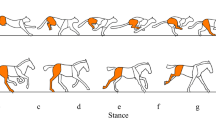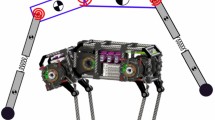Abstract
This study is a feasibility study on the viscoelastic properties of the spinal structure and the stability of the gait in a quadruped locomotion robot with a spinal structure. The leg motions in locomotion are periodic, so the gait is parametrized by the phase difference between each leg motion. On the other hand, we modeled the spinal structure as a sequentially connected structure of vertebrae and intervertebral discs. The structure has nonlinear viscoelastic properties. This study analyzed the viscoelastic properties of the spinal structure and the stability of multiple gait conditions using a simple two-inertia system model. We compared the analysis results using the two-inertia system model with the gait conditions observed by hardware experiments. We confirmed that various stable gait conditions depend on the trunk stiffness and locomotion speed.















Similar content being viewed by others
Data availability
Not applicable.
Code availability
Not applicable.
References
Berstein NA (1967) Co-ordination and regulation of movements. Pergamon Press, Oxford
Graham-Brown T (1922) The physiology of stepping. J Neur Psychopathol 3:112–116
Grillner S (1981) Control of locomotion in bipeds, tetrapods and fish. In: Handbook of Physiology. Sect 1, 2, The Nervous System, Motor Control, pp 1179–1236
Grillner S (1985) Neurobiological bases of rhythmic motor acts in vertebrates. Science 228:143–149
Hoyt DF, Taylor CR (1981) Gait and the energetics of locomotion in horses. Nature 292:239–240
Ekeberg Ö, Pearson K (2005) Computer simulation of stepping in the hind legs of the cat: an examination of mechanisms regulating the stance-to-swing transition. J Neurophysiol 94:4256–4268
Sponberg S, Full RJ (2008) Neuromechanical response of musculo-skeletal structures in cockroaches during rapid running on rough terrain. J Exp Biol 211:433–446
Full RJ, Koditschek DE (1999) Templates and anchors: neuromechanical hypotheses of legged locomotion on land. J Exp Biol 202:3325–3332
Taga G, Yamaguchi Y, Shimizu H (1991) Selforganized control of bipedal locomotion by neural oscillators. Biol Cybern 65:147–159
McMahon TA (1985) The role of compliance in mammalian running gaits. J Exp Biol 115(1):263–282
Fukuoka Y, Kimura H, Cohen AH (2003) Adaptive dynamic walking of a quadruped robot on irregular terrain based on biological concepts. Int J Robot Res 22(3):187–202
McGeer T (1990) Passive dynamic walking. Int J Robot Res 9(2):62–82
Wisse M, Frankenhuyzen J (2005) Design and construction of MIKE: a 2-D autonomous biped based on passive dynamic walking (2005) Proceedings of adaptive motion of animals and machines 2005, Ilmenau, Germany, pp 143–154
Collins S, Ruina A, Tedrake R, Wisse M (2006) Efficient bipedal robots based on passive-dynamic walkers. Science 307:1082–1085
Kim YK, Seol W, Park J (2021) Biomimetic quadruped robot with a spinal joint and optimal spinal motion via reinforcement learning. J Bionic Eng 18:280–290
Culha U, Saranli U (2011) Quadrupedal bounding with an actuated spinal joint. In: Proceedings of the 2011 IEEE international conference on robotics and automation (ICRA), pp 1392–1397
Zhao Q, Sumioka H, Nakajima K et al (2014) Spine as an engine: effect of spine morphology on spine-driven quadruped locomotion. Adv Robot 28(6):367–378
Maleki S, Parsa A, Ahmadabadi MN (2015) Modeling control and gait design of a quadruped robot with active spine towards energy efficiency. In: Proceedings of the 2015 3rd RSI international conference on robotics and mechatronics (ICROM), pp 271–276
Li Z, Yuegang T (2020) Trotting motion of the quadruped model with two spinal joints and its dynamics features. J Robot. https://doi.org/10.1155/2020/3156540
Phan LT, Lee YH, Lee YH, Lee H, Kang H, Choi HR (2020) Study on effects of spinal joint for running quadruped robots. Intel Serv Robot 13:29–46
Zeng S, Tan Y, Li Z et al (2020) Effect of mass-center position of spinal segment on dynamic performances of quadruped bounding with a flexible-articulated spine. Appl Sci 10(4):1491. https://doi.org/10.3390/app1004149
Wang C, Li Y, Sun H, Hou X, Fan C, Yang Y (2021) The dynamics research of quadruped robotics with flexible spine: a review. In: Proceedings of the 2021 6th international conference on control, robotics and cybernetics (CRC). https://doi.org/10.1109/CRC52766.2021.9620119
Adak ÖK, Bahceci B, Erbatur K (2022) Modeling of a quadruped robot with spine joints and full-dynamics simulation environment construction. https://doi.org/10.48550/arXiv.2203.09622
Paul C, Valero-Cuevas FJ, Lipson H (2006) Design and control of tensegrity robots. IEEE Trans Rob 22(5):944–957
Tsujita K, Kobayashi T, Inoura T, Masuda T (2009) Feasibility study on stability of gait patterns with changeable body stiffness using pneumatic actuators in quadruped robot. Adv Robot 23:503–520
Acknowledgements
Not applicable.
Funding
Not applicable.
Author information
Authors and Affiliations
Contributions
The first author, Yasuhiro Okada developed the hardware experimental setup and implemented hardware experiments. The second author, Katsuyoshi Tsujita designed the study, implemented numerical analyses, and wrote the manuscript.
Corresponding author
Ethics declarations
Conflict of interest
The author declares that they have no competing interests.
Rights and permissions
Springer Nature or its licensor (e.g. a society or other partner) holds exclusive rights to this article under a publishing agreement with the author(s) or other rightsholder(s); author self-archiving of the accepted manuscript version of this article is solely governed by the terms of such publishing agreement and applicable law.
About this article
Cite this article
Okada, Y., Tsujita, K. Trunk viscoelasticity and gait stability in quadruped walking. Int. J. Dynam. Control 11, 2368–2379 (2023). https://doi.org/10.1007/s40435-022-01103-3
Received:
Revised:
Accepted:
Published:
Issue Date:
DOI: https://doi.org/10.1007/s40435-022-01103-3




